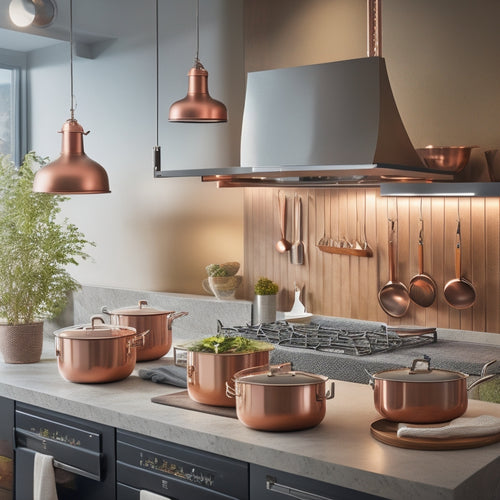
What's the Best Way to Digitize Your Recipes?
Share
To digitize your recipes, begin by decluttering your kitchen countertops and selecting the appropriate digital tool. Scan or upload your recipes, and arrange them with digital downloads. Tag and categorize your recipes for easy access. You can then access your recipes on the move and share them with family. By digitizing your recipes, you'll experience convenient access, space savings, and the capability to add personal touches like notes and photos. Once you've digitized your collection, you'll want to guarantee its preservation - and that's just the start of your digital recipe journey.
Key Takeaways
• Sort and categorize recipes to declutter kitchen space and facilitate easy access to digitized recipes.
• Choose a digital tool that suits your needs, considering ease of use, features, and backup options.
• Scan recipes at high resolution, saving as PDFs or JPEGs, and create a digital index for accessibility.
• Organize and tag digitized recipes, creating an alphabetical index, and update it regularly for efficient searching.
• Implement a backup strategy using cloud storage, external hard drives, or USB flash drives to safeguard digitized recipes.
Decluttering Kitchen Countertops
As you begin to digitize your recipes, start by clearing everything off your kitchen countertops, sorting items into categories, and putting back only what's essential. This minimalist approach will help you focus on what's truly important: the recipes themselves.
You'll be surprised at how much clutter you've accumulated over the years - from worn-out cookbooks to scraps of paper with scribbled notes.
As you sort through your recipes, you'll likely come across old recipe cards that hold sentimental value. Perhaps they were passed down from a loved one or hold memories of special occasions. Set these aside for now, but don't worry - we'll get to preserving their nostalgia later.
For now, focus on decluttering your countertops and creating a sense of calm in your kitchen. A well-organized space will help you stay focused as you work on digitizing your recipes.
Benefits of Digital Recipe Storage
Your digital recipe storage system will become a treasure trove of culinary delights, allowing you to access and explore your favorite dishes with unprecedented ease and flexibility. With digital storage, you'll preserve your cherished recipes for generations to come, ensuring that your family's culinary heritage remains intact.
Additionally, you can customize recipes to suit your taste preferences, dietary needs, and ingredient availability, making meal planning a breeze.
Digital recipe storage also makes searching for specific recipes a snap. No more flipping through cookbooks or scrolling through endless paper printouts. You can instantly find the recipe you need, saving you time and reducing kitchen stress. This increased efficiency will allow you to focus on what matters most – cooking and sharing delicious meals with your loved ones.
Choosing the Right Digital Tool
You have numerous digital tools at your disposal to store and manage your recipes, each offering unique features and benefits that cater to different needs and preferences. When choosing the right digital tool for recipe management, consider what matters most to you. Do you prioritize ease of use, scalability, or advanced features like meal planning and grocery lists? Perhaps you're looking for online resources that allow seamless sharing and collaboration with friends and family.
Some popular digital tools for recipe management include note-taking apps, dedicated recipe organizers, and cloud-based services. Note-taking apps like Evernote or OneNote offer flexibility and customization, while dedicated recipe organizers like Paprika Recipe Manager or BigOven provide more structured templates and features. Cloud-based services like Google Drive or Dropbox allow easy access and sharing across devices.
Take the time to explore these options, reading reviews and watching tutorials to find the best fit for your needs. By choosing the right digital tool, you'll be able to efficiently organize, access, and share your recipes, making meal planning and cooking a breeze.
Scanning and Uploading Recipes
Now that you've selected a digital tool that fits your needs, it's time to populate it with your recipes, starting by scanning and uploading your paper-based collections. This step is essential in recipe organization, as it allows you to preserve your cherished recipes and make them easily accessible on digital platforms.
When scanning, consider the following tips:
| Scanning Tips | Description |
|---|---|
| Resolution | Scan at a high resolution (300 dpi) to make sure text and images are clear. |
| Format | Save scans as PDFs or JPEGs to maintain formatting and quality. |
| Organization | Organize scans by category (e.g., desserts, main courses) for easy retrieval. |
Organizing Recipes With Digital Downloads
Digital downloads can streamline your recipe collection by providing instant access to new recipes, reducing clutter, and allowing you to categorize and search them efficiently. With digital downloads, you can easily organize your recipes into folders or categories, making it simple to find the recipe you need when you need it. You can also tag or label your recipes with keywords, such as 'vegan' or 'holiday,' to make them easy to locate.
When it comes to recipe preservation, online storage is a great option. You can store your digital recipes in cloud-based storage services like Google Drive or Dropbox, ensuring they're safe and accessible from any device. This way, you can rest assured that your recipes are protected from loss or damage, and you can easily share them with others.
Creating a Digital Recipe Index
Creating a digital recipe index allows you to further categorize and refine your digital recipe collection, making it even easier to find specific recipes and plan meals.
This index serves as a roadmap to your virtual cookbook, helping you quickly locate recipes by course, ingredient, cooking method, or occasion.
To create an effective index, start by identifying the categories that matter most to you. You might consider grouping recipes by meal type (breakfast, lunch, dinner), ingredient (vegetarian, gluten-free), or cooking technique (slow cooker, instant pot).
You can also create an alphabetical index, listing each recipe by name. As you add new recipes to your collection, be certain to update your index accordingly. This will guarantee that your digital recipe collection remains organized and easily searchable.
With a well-maintained index, you'll be able to plan meals, generate grocery lists, and cook with confidence, all while enjoying the convenience of your digital recipe organization system.
Tagging and Categorizing Recipes
You'll find that assigning relevant tags and categories to each recipe is an essential step in maintaining a well-organized digital collection. It enables you to filter and search for specific recipes with ease. This is vital for effective recipe organization, allowing you to quickly locate the perfect dish for a dinner party or a specific dietary need.
When tagging your recipes, think about the keywords you'd use to search for them, such as ingredients, cooking methods, or course types. You can also categorize recipes by occasion, season, or cuisine to make them easily accessible.
Accessing Recipes on the Go
With your recipes neatly organized and tagged, accessing them on the go becomes a breeze, allowing you to whip up a meal wherever inspiration strikes. You can easily pull up your favorite recipes on your phone or tablet, even without an internet connection. Consider using recipe app recommendations like Paprika Recipe Manager or BigOven, which allow you to sync your recipes across devices and access them offline.
When cooking with digital recipes, you can quickly scale ingredients, convert units, and even generate grocery lists. You can also join online recipe communities to connect with fellow home cooks, share recipes, and get inspired by new ideas.
With your digital recipe collection at your fingertips, you'll never be stuck without a recipe again. Whether you're at the grocery store, a friend's house, or on a camping trip, your recipes will always be just a tap away.
Sharing Recipes With Family
Two of the biggest benefits of digitizing your recipes are the ease of sharing them with family members and friends who live far away, and the ability to guarantee that your favorite dishes are preserved for generations to come.
With digitization, you can effortlessly share your treasured recipes with loved ones who crave your signature dishes. You can even host a virtual recipe swap or cook-off, where everyone can share and learn from each other's recipes.
Imagine being able to access your grandmother's famous lasagna recipe or your aunt's secret chocolate cake recipe with just a few clicks.
To make sharing even easier, consider creating an online cookbook or using a family recipe app. These tools allow you to store and organize your recipes in one place, making it simple to share them with others. You can also add notes, photos, and videos to make the recipes more personal and engaging.
Backing Up Digital Recipe Files
Now that you've digitized your recipes, it is vital to safeguard them by creating backups of your digital files to prevent loss due to hardware failure, software corruption, or accidental deletion. You've invested time and effort into preserving your family's culinary heritage, and it is crucial to protect it.
To make sure recipe preservation, consider the following backup options:
| Method | Pros | Cons |
|---|---|---|
| Cloud Storage (e.g., Google Drive, Dropbox) | Accessible from anywhere, automated backups, and sharing capabilities | Dependence on internet connection, potential security risks |
| External Hard Drive | Local storage, high capacity, and easy to use | Physical storage limitations, potential hardware failure |
| USB Flash Drive | Portable, easy to use, and low cost | Limited storage capacity, potential data corruption |
Frequently Asked Questions
Can I Digitize Recipes Written in Languages Other Than English?
As you commence on a culinary journey, you wonder: can I digitize recipes in languages other than English? Fear not, for language translation tools and cultural adaptation expertise will preserve your treasured recipes, ensuring seamless digital organization and sharing with loved ones.
How Do I Handle Recipes With Multiple Variations or Adaptations?
When handling recipes with multiple variations, you'll want to create a clear recipe organization system, noting ingredient substitutions and adaptations, so you can easily access and serve the perfect dish for your guests.
Are There Any Copyright Issues With Digitizing Cookbook Recipes?
When digitizing cookbook recipes, you'll face copyright concerns, as seen in the landmark lawsuit against Pinterest for reproducing recipes without permission. Obtain recipe ownership or permission, and consider translating recipes to overcome language barriers.
Can I Use a Digital Tool to Meal Plan and Generate Grocery Lists?
When meal prepping, you'll love using digital tools for organization, translating recipes, and categorizing them for easy access. This streamlined process generates grocery lists, saving time and reducing food waste, making serving others a breeze.
Are Digital Recipes Less Engaging Than Physical Recipe Cards or Books?
Like a warm, fuzzy blanket, physical recipe cards evoke nostalgia, but you'll find digital recipes offer a more intimate connection, allowing you to interact, customize, and engage with your culinary creations in a way physical books can't.
Related Posts
-

Tips for Choosing Under-Cabinet Lighting Fixtures
When choosing under-cabinet lighting fixtures, consider your kitchen's layout and functionality. Assess countertop ma...
-

Ceiling-Mounted Pot Racks for Professional Chefs
Ceiling-mounted pot racks are revolutionary for professional chefs like you. They make use of vertical space, keeping...
-

Under-Sink Storage Bins for Organized Kitchens
Under-sink storage bins are your best bet for an organized kitchen. They maximize unused cabinet space and enhance it...


